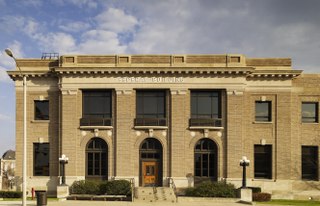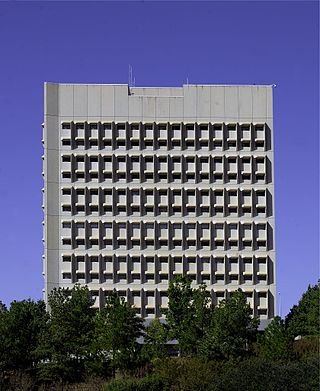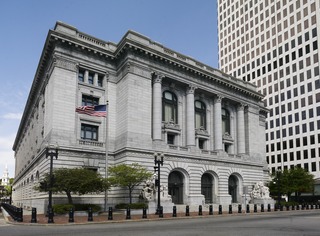Building history
During the 1960s, the federal courts in Baltimore occupied the old U.S. Courthouse and Post Office, now known as Courthouse East, on Calvert Street. The courts rapidly outgrew their facilities, however, and required a larger building to accommodate the growing caseload. In 1970, the U.S. General Services Administration selected a 2.5-acre (10,000 m2) parcel of land bounded by West Pratt, West Lombard, and South Hanover streets and Hopkins Place for a new federal courthouse. Congress allocated funding for the proposed building the same year. The courthouse was designed by RTKL Associates and contains elements of the International Style of architecture, first popularized in the 1930s in Europe and later adopted for federal buildings in the United States. The International Style does not reference regional architectural trends, so similar buildings can be found throughout the United States.
In 1972, the building was named to honor Edward A. Garmatz (1903–1986). Garmatz, who was born and died in Baltimore, was a U.S. Representative for Maryland from 1947 to 1973, serving as the chairman of the Committee on Merchant Marine and Fisheries for much of his political career. Garmatz was elected during a special vote after Thomas D'Alesandro, Jr., resigned his Congressional seat to become mayor of Baltimore.
Completed in 1976 at a cost of $23 million, the new Edward A. Garmatz Federal Building and U.S. Courthouse had 532,020 gross square feet. The federal courts occupied the building later the same year. On May 1, 1978, a dedication ceremony was held in the plaza adjoining the building. In 2004, in Courtroom 5-D of the building, Ed Norris, former superintendent of the Maryland State Police, pleaded guilty to charges that he made illegal personal expenditures from the Baltimore Police Department's discretionary fund while serving as the department's commissioner.
The building's tenants include the U.S. District Court, U.S. Bankruptcy Court, and the U.S. Court of Appeals.
Architecture
The construction of this building was part of an early phase of redevelopment for the area west of the Inner Harbor. Designed by RTKL Associates, a Baltimore-based, multidisciplinary firm of architects, engineers, and planners, the building exhibits characteristics of the International Style of architecture including a simple cubic mass, lack of ornamentation, and horizontal bands of windows. [1,2,3] The designers embraced contemporary trends, materials, and technology to develop an efficient and economical building that eschewed elaborate designs of earlier federal architecture. The nine-story box-like building has an L-shaped footprint with a flat roof. The building is a poured-concrete shell with a strong exterior horizontal emphasis created by alternating concrete strips and bands of fixed windows. The windows are separated by narrow aluminum mullions.
Interior spaces evoke the clean, Modern exterior of the courthouse. Pale grey terrazzo floors and white walls are accented with dark grey painted surfaces and aluminum and silvertone metallic details such as handrails and vent grilles. Green marble panels cover elevator lobby walls, and granite tiles in pale and dark tones cover the floor. Gleaming steel elevator doors and surrounds reinforce the Modern interior design features and finishes. Courtrooms, some of which have been altered to make them appear more Classical, have dark wood wainscoting and jury boxes. Coffered ceilings contain both recessed lighting and hemispherical pendant lights. Clerestory windows with decorative geometric metalwork admit exterior light into some of the courtrooms. A covered patio with brick flooring, planted containers, chairs, and tables provides a transitional space between indoor and outdoor areas.
The U.S. General Services Administration sought to add local context to the site during renovations completed in 2000. Most notably, O'Doherty Group Landscape Architecture redesigned the formerly stark brick plaza to include engaging design features that provide a human scale. Drawing inspiration from Baltimore's past, the landscape architects chose to celebrate the city's mill history, installing a water feature that invokes weirs (dams) and mill races, culminating in a semi-circular fountain base. Designers introduced terraced grassy lawn panels and indigenous plantings. Tiered stone retaining walls of varying lengths are constructed of reclaimed Belgian block from the city's streets and respond to the natural site topography. Unique pyramidal bollards add visual interest to the site while providing security for the building.
Baltimore Federal, a large-scale sculpture by noted artist George Sugarman, was originally installed just outside the building's entrance in 1978. The brightly colored organic forms, executed in painted aluminum, create areas for seating and shelter. The sculpture was initially controversial. [4,5,6,] When the plaza was renovated in 2000, the work was conserved and relocated to its present site at the corner of South Hanover and West Lombard streets. Baltimore-born sculptor Reuben Kramer's rugged bronze depiction of Thurgood Marshall, accomplished lawyer, civil rights advocate, and the first African-American Supreme Court Justice, was unveiled in 1980. It is located on the corner of West Pratt Street and Hopkins Place.

RTKL was a global architecture, planning and design firm. The firm was founded in 1946 by Archibald C. Rogers and Francis T. Taliaferro in Rogers’ grandmother’s basement in Annapolis and grew to be one of the largest architectural firms in the world prior to its acquisition by Arcadis NV in 2007. In October 2015, RTKL was formally merged with another Arcadis subsidiary, Seattle-based Callison, to form CallisonRTKL headquartered in Baltimore.

The Mark O. Hatfield United States Courthouse is a federal courthouse in Portland, Oregon. It is named in honor of former U.S. Senator Mark O. Hatfield. It is used by the United States District Court for the District of Oregon.

The Baltimore City Circuit Courthouses are state judicial facilities located in downtown Baltimore, Maryland. They face each other in the 100 block of North Calvert Street, between East Lexington Street on the north and East Fayette Street on the south across from the Battle Monument Square (1815-1822), which held the original site of the first colonial era courthouse for Baltimore County and Town, after moving the Baltimore County seat in 1767 to the burgeoning port town on the Patapsco River established in 1729-1730.

Charles Center is a large-scale urban redevelopment project in central Baltimore's downtown business district of the late 1950s and early 1960s. Beginning in 1954, a group called the "Committee for Downtown" promoted a master plan for arresting the commercial decline of central Baltimore. In 1955, the "Greater Baltimore Committee", headed by banker and developer James W. Rouse, joined the effort. A plan was developed by noted American urban planner and architect David A. Wallace, (1917−2004), strongly supported by Mayors Thomas L. J. D'Alesandro, Jr. (1947−1959) and Theodore R. McKeldin, and many in their administrations, which formed the basis of a $25 million bond issue voted on by the citizens of Baltimore City during the municipal elections in November 1958. The architects' view of the overall Charles Center Redevelopment Plan with the conceptions of possible buildings, lay-out and plan that was publicized to the voters that spring and summer before, only slightly resembles the actual buildings and designs that later were really constructed by the mid-1970s.

The Spring Street Courthouse, formerly the United States Court House in Downtown Los Angeles, is a Moderne style building that originally served as both a post office and a courthouse. The building was designed by Gilbert Stanley Underwood and Louis A. Simon, and construction was completed in 1940. It formerly housed federal courts but is now used by Los Angeles Superior Court.

The Byron G. Rogers Federal Building and U.S. Courthouse is a historic building on Stout Street in downtown Denver, Colorado, which serves as a courthouse of the United States District Court for the District of Colorado. Completed in 1965, the building was renamed for Colorado Congressman Byron G. Rogers in 1984. In 1996 and 1997, the criminal case against bomber Timothy McVeigh was conducted there. Additionally, the federal building is home to 11 federal agencies, including the United States Patent and Trademark Office's new Rocky Mountain Regional location that opened on June 30, 2014. The building was listed on the National Register of Historic Places in 2016.

The United States Tax Court Building is a courthouse located at 400 Second Street, Northwest, Washington, D.C., in the Judiciary Square neighborhood. It serves as the headquarters of the United States Tax Court. Built in 1972, the building and its landscaped plaza occupy the entire block bound by D Street, E Street, Second Street, and Third street.

The E. Ross Adair Federal Building and U.S. Courthouse is a historic post office, courthouse, and federal office building located at Fort Wayne in Allen County, Indiana. The building is a courthouse of the United States District Court for the Northern District of Indiana. It was listed on the National Register of Historic Places in 2006 as U.S. Post Office and Courthouse.

The United States Courthouse, also known as the Federal Building, is a historic building located in Davenport, Iowa, United States. It has historically housed a post office, courthouse, and other offices of the United States government. The building now serves only as a federal courthouse, housing operations of the eastern division of the United States District Court for the Southern District of Iowa. In 2018, the operations of the Rock Island division of the United States District Court for the Central District of Illinois were also moved there.

The Federal Building, Grand Island, Nebraska is a historic post office, federal office and courthouse building located at Grand Island in Hall County, Nebraska. It is no longer used as a courthouse for the United States District Court for the District of Nebraska.

The Federal Building and U.S. Courthouse, Wheeling, West Virginia is a courthouse of the United States District Court for the Northern District of West Virginia located in the city of Wheeling, West Virginia. Built in 1907, the building still serves its original function, and was renovated and expanded in 1937, and again in 2004. In 1979, it was listed in the National Register of Historic Places in 1979 as a contributing building to the Wheeling Historic District.

The Federal Building and Post Office is a historic main post office, courthouse, and Federal office building in Brooklyn, New York. The original building was the Brooklyn General Post Office, and is now the Downtown Brooklyn Station, and the north addition is the courthouse for the United States Bankruptcy Court for the Eastern District of New York, and is across the street from and in the jurisdiction of the main courthouse of the United States District Court for the Eastern District of New York, the Theodore Roosevelt Federal Courthouse. It also houses offices for the United States Attorney, In 2009, the United States Congress enacted legislation renaming the building the Conrad B. Duberstein United States Bankruptcy Courthouse, in honor of chief bankruptcy judge Conrad B. Duberstein.

The Joel W. Solomon Federal Building and United States Courthouse, commonly referred to as the Solomon Building, is a historic post office and courthouse located at Chattanooga, Tennessee in Hamilton County, Tennessee. The courthouse serves the United States District Court for the Eastern District of Tennessee. The building is listed on the National Register of Historic Places as U.S. Post Office. It was designed by Shreve, Lamb and Harmon and Reuben Harrison Hunt with watercolor murals by Hilton Leech.

The Strom Thurmond Federal Building and United States Courthouse is United States federal building located in Columbia, South Carolina, which was completed in 1979 and which served for twenty-five years as a courthouse of the United States District Court for the District of South Carolina. It is named for long-time Senator Strom Thurmond, and is listed on the National Register of Historic Places.

The Federal Building is a historic post office, courthouse and custom house on Kennedy Plaza in downtown Providence, Rhode Island. It is a courthouse for the United States District Court for the District of Rhode Island. It was built in 1908 by Clarke & Howe of limestone and steel and has a courtyard in the center.

The Joseph F. Weis, Jr. U.S. Courthouse is a Beaux Arts-style building in Pittsburgh, Pennsylvania, US. It is a courthouse for the Western District of Pennsylvania, a United States district court. Until 2015, the building was known as the US Post Office and Courthouse-Pittsburgh.

The E. Barrett Prettyman Federal Courthouse is a historic building in Washington, D.C. It was built in 1949–50 and currently houses the United States District Court for the District of Columbia, the United States Court of Appeals for the District of Columbia Circuit, and the United States Foreign Intelligence Surveillance Court.

The J. Marvin Jones Federal Building and Mary Lou Robinson United States Courthouse, formerly known as the Amarillo U.S. Post Office and Courthouse, is a courthouse of the United States District Court for the Northern District of Texas built in Amarillo, Texas in 1937. It reflects Art Deco architecture and Moderne architecture, and was listed on the National Register of Historic Places in 2000. In addition to its continuous use as a courthouse, it has served as a post office, as a customhouse, and as a government office building.

The Little Rock U.S. Post Office and Courthouse, also known as Old Post Office and Courthouse, in Little Rock, Arkansas, is a historic post office, federal office, and courthouse building located at Little Rock in Pulaski County, Arkansas. It is a courthouse for the United States District Court for the Eastern District of Arkansas.

The William Kenzo Nakamura United States Courthouse is a federal courthouse in Seattle, Washington primarily used by the United States Court of Appeals for the Ninth Circuit. Built in 1940 as the United States Courthouse to consolidate federal agencies within the city, it was renamed for Medal of Honor recipient William K. Nakamura in 2001. The Ninth Circuit started using the building in the 1970s and became the principal tenant in 2004 when most other users moved to the new 23-story United States Courthouse in the Denny Triangle.




















